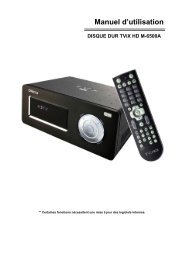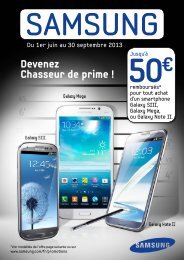MECABLITZ 50 AF-1 digital - Materiel.net
MECABLITZ 50 AF-1 digital - Materiel.net
MECABLITZ 50 AF-1 digital - Materiel.net
Create successful ePaper yourself
Turn your PDF publications into a flip-book with our unique Google optimized e-Paper software.
10 Flash techniques<br />
10.1 Bounce flash<br />
Bounce flash illuminates the subject more softly and reduces dense shadows. It<br />
also reduces the drop in light from foreground to background that occurs for<br />
physical reasons.<br />
The main reflector � of the flash unit can be swivelled horizontally and tilted<br />
vertically for bounce flash. To do this, depress the reflector unlocking button �<br />
and tilt the reflector �. To avoid colour cast in your shots, the reflective surface<br />
should be colour-neutral or white.<br />
☞ The main reflector is not locked in place in any swivelled positions other<br />
than 0°.<br />
☞ When tilting the main reflector � vertically, make sure that it is turned<br />
through an angle that is wide enough to prevent direct light from falling<br />
on the subject. For this reason the reflector should be tilted at least as far<br />
as the 60° lock-in position. Flash ranges do not appear on the display<br />
when the main reflector is turned! When the reflector head is tilted, the<br />
main reflector is moved to a position of greater/equal 70 mm in order to<br />
prevent the subject from being additionally illuminated by dispersed<br />
light. The range and position of the main reflector is not displayed.<br />
10.2 Bounce flash with a reflector card<br />
The use of bounce flash with the integrated reflector card � can bring out highlights<br />
in the eyes of human subjects:<br />
• Tilt the reflector head upwards by 90°.<br />
• Pull the reflector card � together with the<br />
wide-angle diffuser from above out of the reflector<br />
head and forwards.<br />
• Hold the reflector card � and push the wide-angle<br />
diffuser � back into the reflector head.<br />
10.3 Close-ups / macro shots<br />
In close-ups and macro shots, parallax error between the flash unit and lens<br />
may result in shadows on the lower edge of the image. To compensate for this,<br />
the main reflector � can be tilted downwards by an angle of -7°. To do this,<br />
depress the reflector unlocking button � and tilt the reflector downward.<br />
Certain minimum lighting distances must be maintained for close-up shots to<br />
avoid over-exposure.<br />
☞ The minimum lighting distance is approximately 10% of the maximum<br />
flash range indicated in the display. When the reflector head is tilted<br />
downwards, the maximum flash range flashes as an indication. For close-up<br />
shots, make sure that the flash light is not shaded by the lens!<br />
107<br />
�





